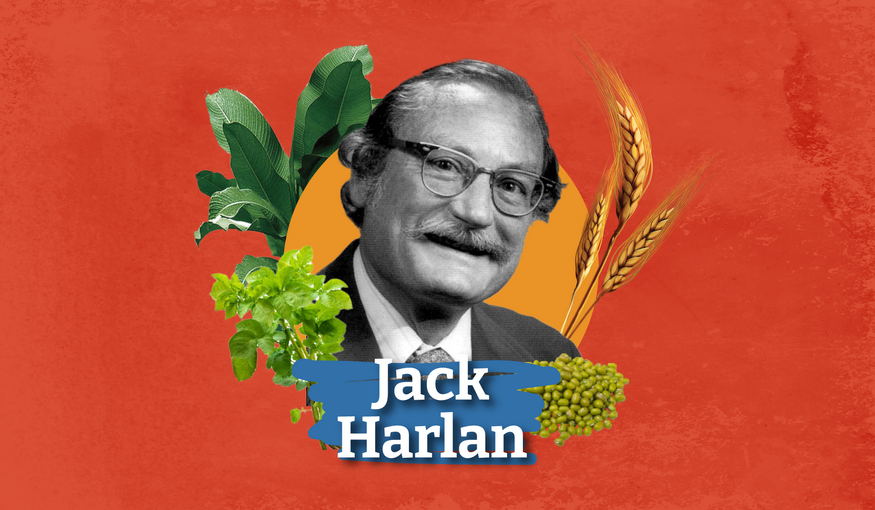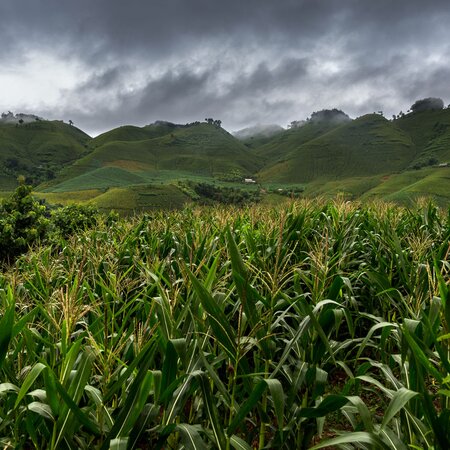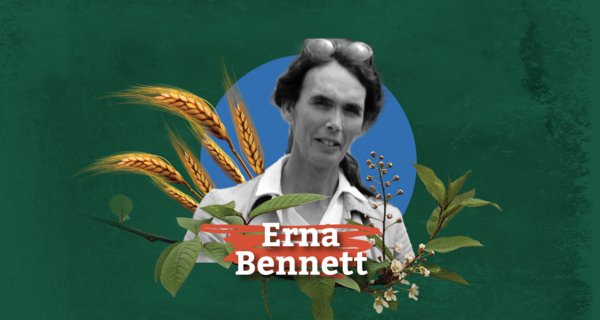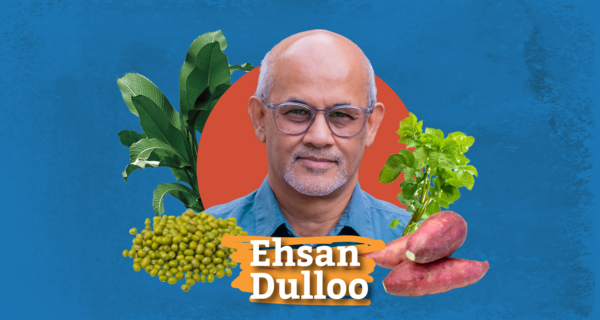Jack Harlan: Sounding the Alarm on Crop Diversity Loss

19 May 2025
In this edition, our Seed Heroes series pays tribute to U.S. scientist Jack Harlan. His plant collection expeditions and profound multidisciplinary knowledge helped shape the future of crop diversity conservation and genebanks.
Jack Harlan had a clear vision of what happens when we lose crop diversity.
“These resources stand between us and catastrophic starvation on a scale we cannot imagine,” he wrote in a 1972 paper. “For the sake of future generations, we must collect and study wild and weedy relatives of our cultivated plants as well as the domesticated races.”
The U.S. plant geneticist was among the first to raise concerns about the Green Revolution, which began in the mid-20th century intending to boost production of food grains in developing countries. He warned that modern crop varieties, widely distributed around the world, were replacing the traditional varieties, or landraces, that farmers had grown for hundreds, if not thousands, of years. This, he argued, was leading to the loss of valuable genetic diversity.
Crop genetic diversity – in genebanks, on farms, and in the wild – is essential for global food security. Scientists and plant breeders rely on this diversity to create new varieties that can handle climate change, feed a growing population, offer better nutrition and support farmers’ incomes, especially in developing countries.
In Genetics of Disaster, Harlan used strong terms like “genetic wipeout” to describe the risk of relying on too few crop varieties. Like his father, he feared what could happen if we didn’t protect the diversity our food depends on.
His journey as a plant geneticist began in childhood. Harlan was influenced by his father, a barley collector for the U.S. Department of Agriculture, and experts like Russian agronomist Nikolai Vavilov.
As Harlan’s career flourished, he became a powerful voice warning about the loss of crop diversity. He also inspired the next generation, including Cary Fowler, a winner of the 2024 World Food Prize.

Jack Harlan smokes a pipe in front of a maize field. Photo: University of Illinois
Champion Collector
Harlan’s plant exploration work was legendary. Over 35 years, he traveled to 45 countries and collected more than 12,000 samples of wheat, barley, maize, legumes, forage grasses and other plants. These trips, funded by the U.S. government, helped build a collection of plant diversity that scientists still use today.
His wide-ranging interests – from botany and genetics to history and archaeology – helped shape the modern field of plant genetic resources. Harlan was a key figure in making it an area of scientific study that crosses many disciplines. His deep understanding of how crops and people evolved together had a lasting impact on his colleagues and students.
In his 1995 book The Living Fields: Our Agricultural Heritage, Harlan explored the human relationship with crops. “Our domesticated cereals cannot survive without us, and we cannot survive without them. The symbiosis is complete; one cannot live without the other. This is where we stand, and the ground is not very firm,” he wrote.
Fowler’s Inspiration
In the 1970s, Harlan’s work alerted Fowler to the catastrophic consequences of crop diversity loss. This led Fowler to dedicate his life to conserving crop diversity for humankind, a vision that helped establish the Svalbard Global Seed Vault, the world’s ultimate backup facility for seed collections.
“What he understood was that biological diversity – crop diversity – is the foundation of agriculture,” Fowler said of Harlan in a 2009 TED Talk. “It’s the raw material, the stuff of evolution in our agricultural crops. Not a trivial matter. And he also understood that that foundation was crumbling, literally crumbling. That, indeed, a mass extinction was underway in our fields, in our agricultural system.”
Early Life
Jack Rodney Harlan was born on 7 June 1917 in Washington, D.C. He was the younger of two sons of Harry Vaughn and Augusta Griffing Harlan, according to a 2003 memoir published by the U.S. National Academy of Sciences.
His father led barley investigations for the U.S. Department of Agriculture (USDA) for 34 years, collecting plant samples in South America, Asia, Europe and Africa. During the summer months, Jack and his brother Bill accompanied their father to the barley research stations in Aberdeen, Idaho, and Sacaton, Arizona.
As a teenager, Harlan’s path to a career in plant genetics took a decisive turn when his father introduced him to Vavilov. Later known as the “father of genebanks,” Vavilov was visiting the United States in 1932 for the Sixth International Congress of Genetics.
After earning a Bachelor of Science degree from George Washington University in 1938, Harlan planned to study under Vavilov in St. Petersburg, Russia. But the Russian scientist was arrested during a collecting expedition in western Ukraine and was accused of being a traitor and a British spy. Vavilov died of starvation in a Soviet prison in 1943.
On Vavilov’s Trail
Decades later, Harlan updated Vavilov’s idea of eight geographically defined “centers of origin” for domesticated plants around the world. He proposed that agriculture started independently in three broad areas rather than pinpointable centers. In each of these, farmers domesticated crops and developed agriculture gradually and independently in multiple, overlapping locations, according to Harlan’s 1971 paper on the topic.
Harlan completed a doctorate in genetics at the University of California in 1942 and began his career in the U.S. Department of Agriculture at Woodward, Oklahoma, in the same year. There he directed the Oklahoma Forage Crop and Rangeland Improvement program and the Southern Great Plains Regional Grass Breeding program.
In 1951, he transferred to Oklahoma State University in Stillwater and became a professor of genetics. More than a decade later, Harlan moved to the University of Illinois and became a professor of plant genetics in the Department of Agronomy.
With his colleague Professor J.M. deWet, Harlan founded the Crop Evolution Laboratory in 1967 for graduate study of cultivated plants and their wild relatives. Together, they developed a system that taxonomists and plant breeders still use to classify cultivated plants.
Harlan retired from the University of Illinois in 1984.
The Crop Trust acknowledges the remarkable contribution of Jack Harlan as a pioneer of crop diversity conservation, as a multidisciplinary visionary and as an inspiration to generations of plant scientists.
Timeline:
- 1917: Born in Washington, D.C.
- 1938: Earns Bachelor of Science degree at George Washington University
- 1939: Marries Jean Yocum in Berkeley, California
- 1942: Awarded doctorate in genetics from University of California
- 1942: Begins work at U.S. Department of Agriculture in Woodland, Oklahoma
- 1948: Leads plant exploration trip to Turkey, Syria, Lebanon and Iraq
- 1951: Transfers to Oklahoma State University, Stillwater, as professor of genetics
- 1960: Leads plant exploration trip to Iran, Afghanistan, Pakistan, India and Ethiopia
- 1966: Moves to University of Illinois as professor of plant genetics
- 1967: Establishes the Crop Evolution Laboratory with Professor J.M. deWet
- 1971: Publication of paper Agricultural origins: Centers and noncenters
- 1972: Elected member of the National Academy of Sciences
- 1984: Retires from University of Illinois with the rank of professor emeritus
- 1998: Dies in New Orleans, Louisiana, at age 81
- 1999: Crop Sciences Society of America holds symposium in Harlan’s honor
Categories: For Educators, For Students, BOLD, Food Security, Sustainable Agriculture




